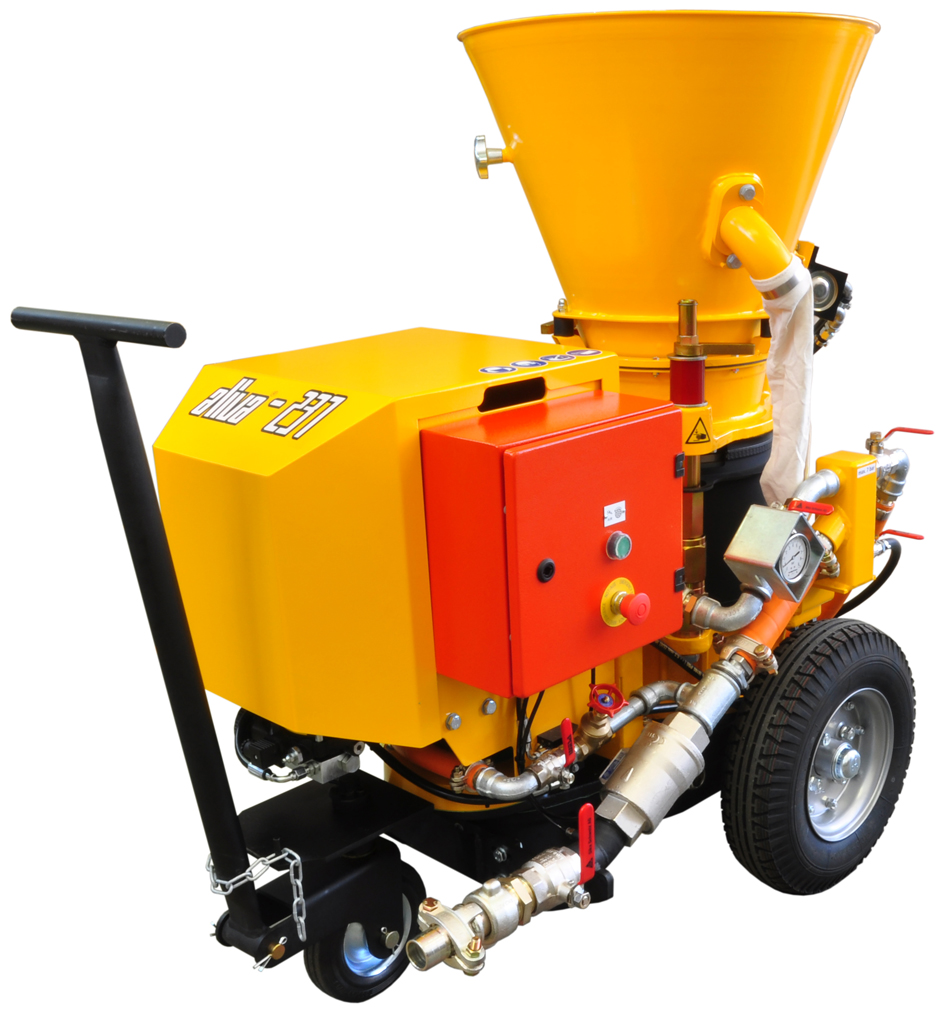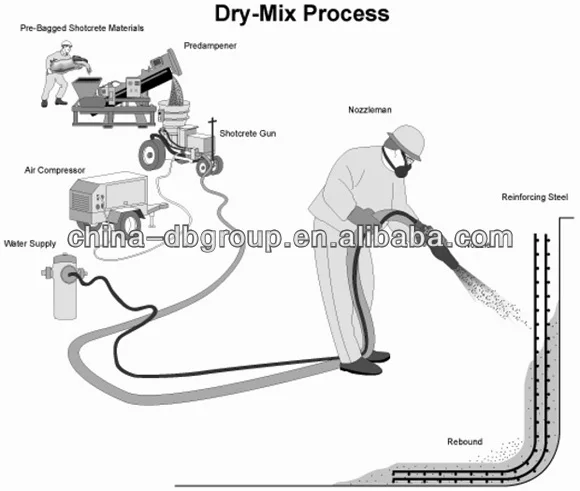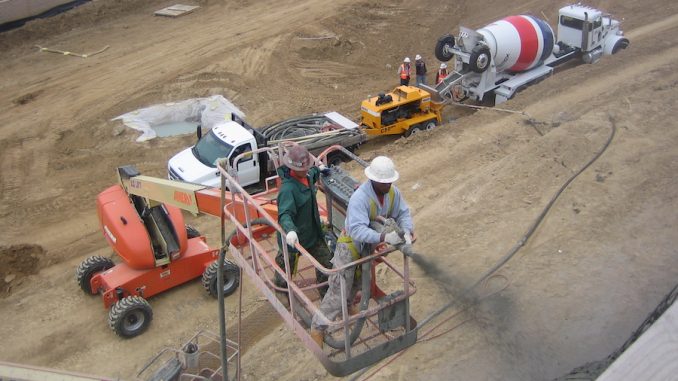Dry Shotcrete
Gunite machines use air pressure to convey dry material from the machine through the hose to the nozzle where water is added. SPZ Series Electric Dry-mix Shotcrete Machine is a low to high production, continuous-feed material placement unit for dry-mix gunite or refractory materials. The dry process entails first placing pre-blended dry or semi-dampened materials into the shotcrete equipment’s hopper, which is subsequently metered into a delivery hose. Then, compressed air conveys material at high velocity to the nozzle, where water is added. Shotcrete shall be comprised of Portland Cement, coarse and fine aggregate, water and admixture(s), properly mixed to provide a consistency to allow spray onto a construction face by means of compressed air using pneumatic pumps and special nozzles. Shotcrete is usually an all-inclusive term for both the wet-mix and dry-mix versions. In pool construction, however, shotcrete refers to wet mix and gunite to dry mix. In this context, these terms are not interchangeable. Shotcrete is placed and compacted/consolidated at the same time, due to the force with which it is ejected from the nozzle.


Dry Shotcrete Equipment
Shotcrete, gunite (/ˈɡʌnaɪt/), or sprayed concrete is concrete or mortar conveyed through a hose and pneumatically projected at high velocity onto a surface, as a construction technique, first used in 1914.[1]:7 It is typically reinforced by conventional steel rods, steel mesh, or fibers.
Shotcrete is usually an all-inclusive term for both the wet-mix and dry-mix versions. In pool construction, however, shotcrete refers to wet mix and gunite to dry mix. In this context, these terms are not interchangeable.
Shotcrete is placed and compacted/consolidated at the same time, due to the force with which it is ejected from the nozzle. It can be sprayed onto any type or shape of surface, including vertical or overhead areas.


History[edit]
Shotcrete, then known as gunite, was invented in 1907 by American taxidermistCarl Akeley to repair the crumbling façade of the Field Columbian Museum in Chicago (the old Palace of Fine Arts from the World's Columbian Exposition).[2] He used the method of blowing dry material out of a hose with compressed air, injecting water at the nozzle as it was released. In 1911, he was granted a patent for his inventions, the 'cement gun', the equipment used, and 'gunite', the material that was produced. There is no evidence that Akeley ever used sprayable concrete in his taxidermy work, as is sometimes suggested. F. Trubee Davison covered this and other Akeley inventions in a special issue of Natural History magazine.[3]
The dry-mix process was used until the wet-mix process was devised in the 1950s. In the 1960s, an alternative method for gunning dry material with a rotary gun appeared, using a continuously fed open hopper.
The nozzle is controlled by hand on small jobs, such as a modest swimming pool. On larger work it is attached to mechanical arms and operated by hand-held remote control.
Dry vs. wet mix[edit]
The dry mix method involves placing the dry ingredients into a hopper and then conveying them pneumatically through a hose to the nozzle. The nozzleman controls the addition of water at the nozzle. The water and the dry mixture is not completely mixed, but is completed as the mixture hits the receiving surface. This requires a skilled nozzleman, especially in the case of thick or heavily reinforced sections. Advantages of the dry mix process are that the water content can be adjusted instantaneously by the nozzleman, allowing more effective placement in overhead and vertical applications without using accelerators. The dry mix process is useful in repair applications when it is necessary to stop frequently, as the dry material is easily discharged from the hose.
Wet-mix shotcrete involves pumping of a previously prepared concrete, typically ready-mixed concrete, to the nozzle. Compressed air is introduced at the nozzle to impel the mixture onto the receiving surface. The wet-process procedure generally produces less rebound, waste (when material falls to the floor), and dust compared to the dry-mix process. The greatest advantage of the wet-mix process is all the ingredients are mixed with the water and additives required, and also larger volumes can be placed in less time than the dry process concrete .
Shotcrete machines[edit]

Shotcrete machines are available which control the complete process and make it very fast and easy. Manual and mechanical methods are used for the wet spraying process but wet sprayed concrete is traditionally applied by machine. The high spray outputs and large cross-sections require the work to be mechanised. Concrete spraying systems with duplex pumps are mainly used for working with wet mixes. Unlike conventional concrete pumps, these systems have to meet the additional requirement of delivering a concrete flow that is as constant as possible, and therefore continuous, to guarantee homogeneous spray application'.[1](6.1.2 Machines)
Shotcrete vs. gunite[edit]
Gunite was originally a trademarked name that specifically referred to the dry-mix pneumatic cement application process. In the dry-mix process, the dry sand and cement mixture is blown through a hose using compressed air, with water being injected at the nozzle to hydrate the mixture, immediately before it is discharged onto the receiving surface. Gunite was the original term coined by Akeley, trademarked in 1909 and patented in North Carolina. The concrete mixture is applied by pneumatic pressure from a gun, hence 'gun'-ite.
The term 'Gunite' became the registered trademark of Allentown Equipment, the oldest manufacturer of gunite equipment. Other manufacturers were thus compelled to use other terminology to describe the process such as shotcrete, pneumatic concrete, guncrete, etc.
Shotcrete is an all-inclusive term for spraying concrete or mortar with either a dry or wet mix process. However, shotcrete may also sometimes be used (incorrectly) to distinguish wet-mix from the dry-mix method. The term shotcrete was first defined by the American Railway Engineers Association (AREA) in the early 1930s.[4] By 1951, shotcrete had become the official generic name of the sprayed concrete process—whether it utilizes the wet or dry process.[4]
Applications[edit]
Shotcrete is commonly used to line tunnel walls, in mines, subways, and automobile tunnels. Fire-resistant shotcrete developed in Norway is used on the Marmaray tunnel in Istanbul.[5]
Shotcrete is used to reinforce both temporary and permanent excavations. It may be employed, in concert with lagging and other forms of earth anchor, to stabilize an excavation for an underground parking structure or hi-rise during construction. This provides a large waterproof enclosure in which a structure can be erected. Once the structure is completed the area between its foundation and the shotcrete is backfilled and compacted.
Shotcrete is also a viable means and method for placing structural concrete.[citation needed]
Shotcrete is very useful in hard rock mining. Development of decline pathway to go underground is critical for movement of heavy machinery, miners, and material. Shotcrete helps make these paths safe from any ground fall.[6]
In-ground swimming pools can use either the wet or dry application method. Shotcrete-wet is ideal for covering large areas quickly, whereas shotcrete-dry (Gunite) is more useful for frequent start-and-stop operations. Neither is superior for this application, and the technique should be selected based on individual project needs.
Costs vary depending on project needs. [7] Shotcrete swimming pools are typically more durable and longer lasting than poured concrete. Poured concrete can have a compressive strength of 2,500-3,000 psi, whereas shotcrete exceeds 4,000 psi. Additionally, the use of Shotcrete allows for customization in shape, depth, and styles that are not typically available in traditional pool kits.[8]
Shotcrete Dry Time
See also[edit]
- The Flintstone House – an example of shotcrete housing construction
Notes[edit]
- ^ abHöfler, Jürgen; Schlumpf, Jürg (March 2004). Shotcrete in Tunnel Construction, Introduction to the basic technology of sprayed concrete(PDF). Sika AG.
- ^Teichert, Pietro (Summer 2002). 'Carl Akeley--a tribute to the founder of Shotcrete'(PDF). Shotcrete: 10–12. Retrieved 13 April 2014.
- ^Davison, F. Trubee (March–April 1927). 'Akeley, the inventor'. Natural History. XXVII (2): 124–129.
- ^ abACI Report 506R-05
- ^'Norwegian technology in the world's deepest immersed tunnel' (in Norwegian) Teknisk Ukeblad, 12 October 2013. Accessed: 13 October 2013. Technical report : Claus K. Larsen. 'Testing of fireproofing for concrete' 'Norwegian Public Roads Administration, 2007.
- ^WSN 2014, B. Simser - Empirical experience with shotcrete in deep underground mines
- ^'Cost to install a Gunite concrete pool - Estimates and Prices at Howmuch'. HowMuch. Retrieved 2017-10-04.
- ^Aquapool. 'Gunite and inground gunite pools Aqua pool & Patio New Pool Construction, Renovation, Installation and Design'. Aqua pool & Patio New Pool Construction, Renovation, Installation and Design. Retrieved 2017-10-04.
Dry Shotcrete Vs Wet Shotcrete
External links[edit]
| Wikimedia Commons has media related to Shotcrete. |